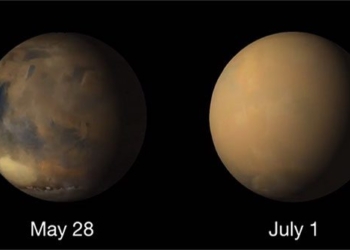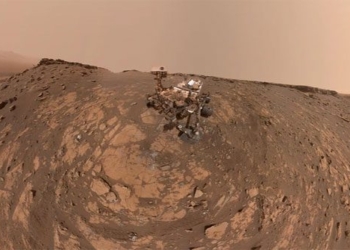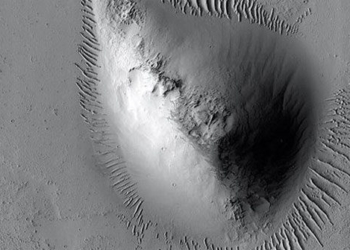Scientists believe that whether it is today’s Mars exploration or the future development of Mars, the greatest threat they face is not the distant journey but rather the dust storms on Mars.
As a planet with a surface composed entirely of sand and gravel, dust storms on Mars occur approximately once every five years (based on Earth time). Due to Mars’s significantly weaker gravitational pull compared to Earth and its atmosphere being only 1% as thick as Earth’s, dust storms on Mars can last for several months. During this time, the surface of Mars remains dark. When observing Mars from Earth, all details are lost due to the dust storms.
During a dust storm on Mars, all Mars exploration vehicles lose solar energy and are buried by wind and sand. Once the dust storm finally subsides, the Mars rovers essentially lose contact with Earth forever, making it crucial for people to at least avoid the dust storm cycles.

Dust storms on Mars can form at rates dozens of times faster than dust storms on Earth. When Martian dust encounters the thin atmosphere from the two moons, Phobos and Deimos, it generates heat, creating columns of spiraling air into vertical columns. According to scientists at NASA, dust storms on Mars generate electricity and magnetic fields at significant levels. Dust particles in the storm become electrically charged as they rub against each other, with smaller particles acquiring a negative charge and larger particles acquiring a positive charge. (Image: Zhihu).
There is substantial evidence that Mars had a thick atmosphere and a global ocean around 4 billion years ago. The ice caps at Mars’s poles, as well as riverbeds and seabeds across its surface, can attest to this. Astronomical researchers believe that there may have been life on Mars in its distant past or in the early stages of Martian civilization. However, with the disappearance of Mars’s global magnetic field, this life is no longer present.
For any planet in the Solar System, lacking a sufficiently strong magnetic field to fend off solar winds is catastrophic, as charged particles in solar winds continually strip the planet’s atmosphere and vaporize liquid water. Mars’s current appearance is largely due to its core cooling down too quickly, leading to the loss of its global magnetic field. A more visual comparison shows that Earth is the heaviest rocky metal planet in the Solar System, with its liquid iron and nickel core never ceasing to flow and showing no signs of cooling, thus allowing Earth’s magnetic field to remain stable over long periods.

Billions of years ago, vast rivers and lakes were believed to have stretched across the surface of Mars before transforming into the arid desert we see today. The first evidence was discovered in 2012 when the Curiosity rover explored the massive Gale Crater, which was previously thought to have contained a lake and a towering sedimentary mountain nearly 6 kilometers high at its center. According to research published in the journal Nature, while climbing the slopes of the sedimentary mountain in 2021, the Curiosity rover found hexagonal salt formations in soil dated to nearly 4 billion years ago and identified these as cracks on the dry mud floor—indicators of a lake that had dried up. (Image: Zhihu).
However, humanity cannot remain on Earth indefinitely, so studying the mechanisms of Mars’s formation and its dust storms is essential for future human migration. Yet, at this moment, the scientific community is unable to do much because there is currently too little data on this—all available equipment does not function properly in Martian dust storms.
In NASA’s Mars plan, human settlements may be located underground or within enclosed dome structures, utilizing solar energy as well as nuclear energy as a backup.

The plan to colonize Mars is not a random idea or a reckless endeavor. On the contrary, it is humanity’s thoughtful consideration of the future, reflecting the desire to explore the endless universe, seek new resources, and expand humanity’s living space. If we can successfully establish a stable human community on Mars, it will mark an important milestone for humanity’s exploration of the universe and even the discovery of new living spaces. Mars is one of the closest planets to Earth in the Solar System, with many natural cycles and terrain similar to Earth. More importantly, Mars has resources such as water, carbon dioxide, and oxygen that are crucial for human survival. These features make Mars the top choice for those seeking a second home. (Image: Zhihu).
However, Mars remains a planet where humans have never lived, and the so-called current Mars plan may not be feasible on the planet. Humanity still has a long way to go from Earth to Mars and to establish a truly diverse civilization.





















































